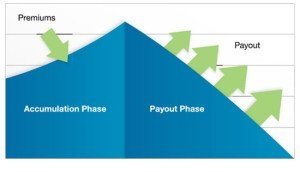What Is An Annuity?
Individuals hold more than $2.0 trillion in annuity contracts; a tidy sum considering an estimated $7.4 trillion is held in all types of IRAs.1
Simply put, annuity contracts are purchased from an insurance company. The insurance company will then make regular payments — either immediately or at some date in the future. These payments can be made monthly, quarterly, annually, or as a single lump-sum. Annuity contract holders can opt to receive payments for the rest of their lives or for a set number of years.
The money invested in an annuity grows tax-deferred. When the money is withdrawn, the amount contributed to the annuity will not be taxed, but earnings will be taxed as regular income. There is no contribution limit for an annuity.
There are two main types of annuities:
Fixed annuities offer a guaranteed payout, usually a set dollar amount or a set percentage of the assets in the annuity.
Variable annuities offer the possibility to allocate premiums between various subaccounts. This gives annuity owners the ability to participate in the potentially higher returns these subaccounts have to offer. It also means that the annuity account may fluctuate in value.
– Fixed indexed annuities are specialized hybrid annuities. They are classified as fixed annuities however during the accumulation period, the rate of return is based on a market index.
Annuities have contract limitations, fees, and charges, including account and administrative fees, underlying investment management fees, mortality and expense fees, and charges for optional benefits. Most annuities have surrender fees that are usually highest if you take out the money in the initial years of the annuity contact. Withdrawals and income payments are taxed as ordinary income. If a withdrawal is made prior to age 59½, a 10% federal income tax penalty may apply (unless an exception applies). The guarantees of an annuity contract depend on the issuing company’s claims-paying ability. Annuities are not guaranteed by the FDIC or any other government agency.
Variable annuities are sold by prospectus, which contains detailed information about investment objectives and risks, as well as charges and expenses. You are encouraged to read the prospectus carefully before you invest or send money to buy a variable annuity contract. The prospectus is available from the insurance company or from your financial professional. Variable annuity subaccounts will fluctuate in value based on market conditions, and may be worth more or less than the original amount invested when the annuity expires.
Two Phases
Deferred annuity contracts go through two distinct phases: accumulation and payout. During the accumulation phase, the account grows tax deferred. When it reaches the payout phase, it begins making regular payments to the contract owner — in this case annually.
Case Study: Robert’s Fixed Annuity
Robert is a 52-year-old business owner. He uses $100,000 to purchase a deferred fixed annuity contract with a 4% guaranteed return.
Over the next 15 years, the contract will accumulate tax deferred. By the time Robert is ready to retire, the contract should be worth just over $180,000.
At that point the contract will begin making annual payments of $13,250. Only $7,358 of each payment will be taxable; the rest will be considered a return of principal.
These payments will last the rest of Robert’s life. Assuming he lives to age 85, he’ll eventually receive over $265,000 in payments.
Robert’s annuity may have contract limitations, fees, and charges, including account and administrative fees, underlying investment management fees, mortality and expense fees, and charges for optional benefits. His annuity also may have surrender fees that would be highest if Robert takes out the money in the initial years of the annuity contact. Robert’s withdrawals and income payments are taxed as ordinary income. If he makes a withdrawal prior to age 59½, a 10% federal income tax penalty may apply (unless an exception applies).
With so many different types of annuities in the marketplace, all with different features and objectives, it can sometimes become a daunting task figuring out which direction to go with. We encourage you to seek out professional advice to find the right one for you. If you currently own an annuity and would like us to perform our annuity cost & benefits review, contact us today.
- Insured Retirement Institute, 2015; Investment Company Institute, 2015

